How to Identify Asbestos in Home and Steps for Safe Removal

Asbestos, once a popular building material due to its fire-resistant and insulating properties, is now known for its hazardous health effects. Identifying and safely removing asbestos from your home is crucial for protecting your health and that of your family. This guide provides you with comprehensive information on how to recognise asbestos and proceed with its safe removal.
Understanding Asbestos
Asbestos is a group of six naturally occurring silicate minerals, each composed of long, thin fibrous crystals. Due to its durability, resistance to heat, and insulating properties, it was extensively used in building materials until the late 20th century. Common places you might find asbestos include old floor tiles, ceiling tiles, roof shingles, siding, insulation, and around pipes.
Identifying Asbestos in Your Home
- Consider the Age of Your Home: Homes built or renovated before the 1980s are more likely to contain asbestos. Identifying the construction period can be a primary indicator.
- Look for Common Asbestos-Containing Materials: Vinyl floor tiles, insulation around boilers and pipes, and textured paints are typical asbestos carriers.
- Check for Signs of Wear or Damage: Damaged materials may release asbestos fibres into the air, which are harmful when inhaled.
Importance of Professional Asbestos Testing
While there are DIY asbestos testing kits, the safest way to confirm the presence of asbestos is through professional testing. A trained expert can take samples without increasing your risk of exposure and provide accurate results.
Steps to Take If You Suspect Asbestos
- Do Not Disturb the Material: If you suspect a material contains asbestos, avoid touching or disturbing it as this can release fibres into the air.
- Contact Professionals for Testing and Removal: For safe asbestos removal in Bournemouth, seeking help from certified professionals is essential.
Choosing the Right Asbestos Removal Professional
When selecting a professional for asbestos removal, ensure they are licensed and have a good track record. Check for certifications and reviews from other homeowners.
Preparing for Asbestos Removal
- Notify Your Family and Neighbours: Informing those around you about the removal process is important for everyone’s safety.
- Seal the Area: Professionals will seal off the work area to prevent the spread of asbestos fibres.
Asbestos Removal Process
- Containment and Ventilation: Experts use containment methods and proper ventilation to ensure fibres do not escape into other parts of your home.
- Safe Removal Techniques: Specialised vacuum cleaners and protective gear are used to safely remove asbestos.
Post-Removal Safety Measures
After asbestos removal, ensure the area is thoroughly cleaned and inspected by professionals to confirm that no asbestos remains.
Health Implications of Asbestos Exposure
Long-term exposure to asbestos can lead to serious health issues such as asbestosis, lung cancer, and mesothelioma. Understanding these risks underscores the importance of proper identification and removal.
Preventing Future Asbestos Risks
- Stay Informed: Know the materials in your home and keep records of any asbestos removal.
- Regular Home Inspections: Especially in older homes, regular inspections can help detect potential asbestos-containing materials before they pose a risk.
By following these steps and working with professionals, you can ensure the safe identification and removal of asbestos from your home, protecting your health and the well-being of those around you.




